5 Easy Korean Zucchini Recipes (Banchan Side Dishes).
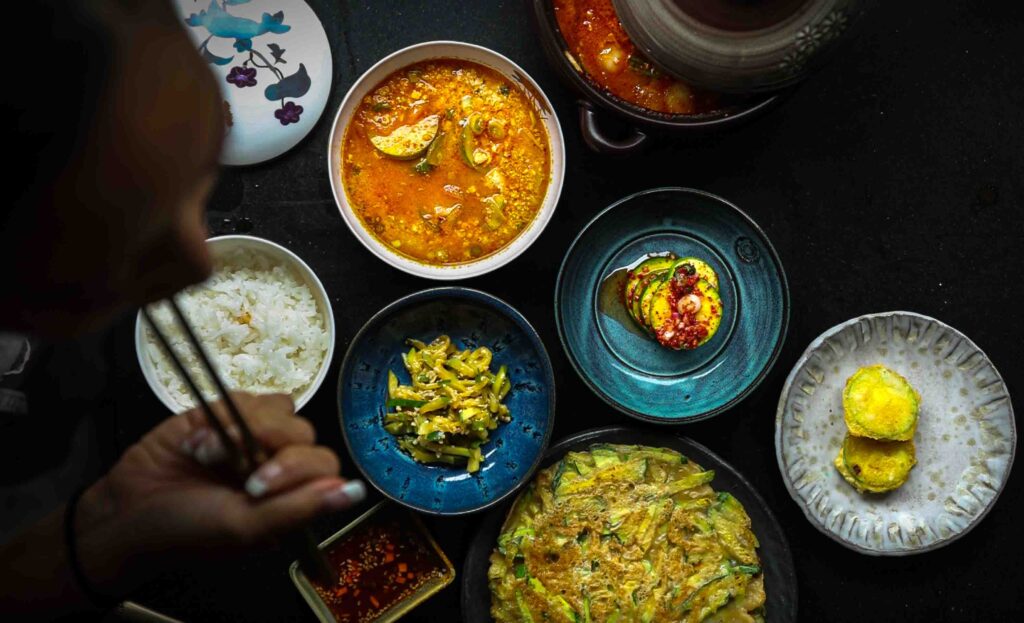
Easy. Nutritious. TOTALLY DELICIOUS.
If you want to create an entire Korean meal (shik-sah) featuring one of summer’s BEST ingredients, these 5 Korean zucchini recipes are going to knock your freaking socks off!!
So, grab a lot of zucchini, set aside an hour, and get ready to dine on one of the most satisfying meals of your LIFE!
Let’s do this!
Disclaimer: Some of the links in this post may be affiliate links for products I use and love. If you make a purchase after clicking one of those links, I may earn a small affiliate commission, perhaps enough to buy some extra gochujang or gochugaru 🙂
What Is Korean Zucchini?
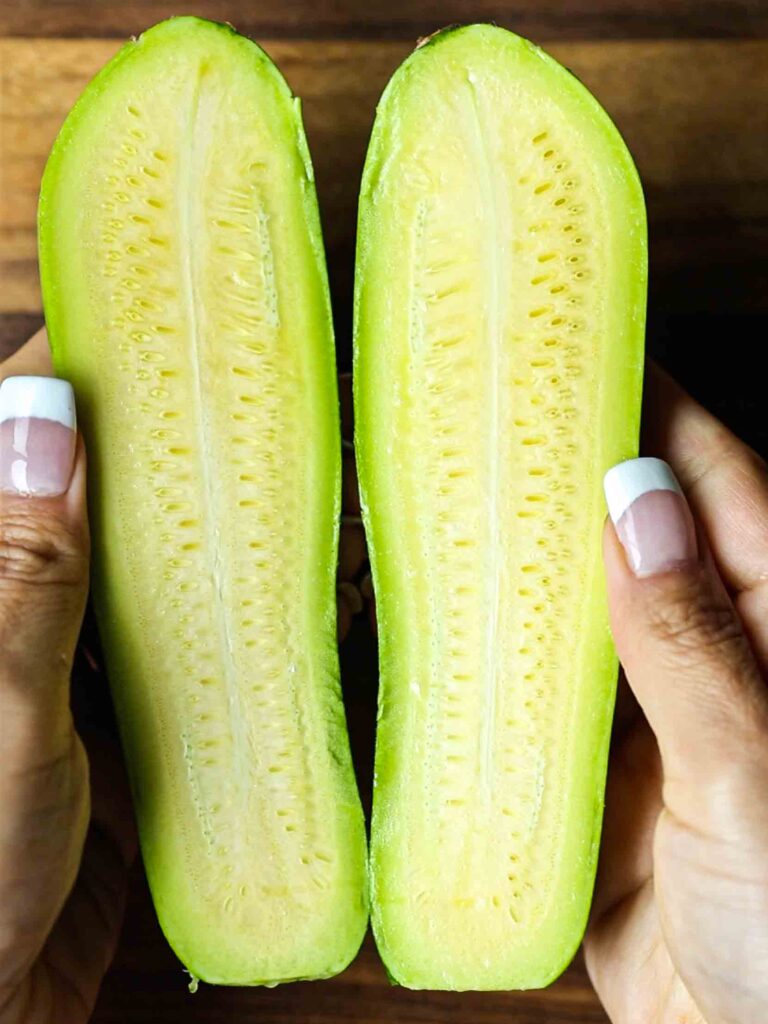
Usually when you hear the term “zucchini” (or courgette), you think of that dark green summer squash from the cucurbita pepo species. You can find them in abundant supply at your local grocery store or farmer’s market pretty much year round.
What, then, is a “Korean zucchini”?
Korean zucchini looks a lot like regular zucchini and even tastes a lot like regular zucchini. But, Korean zucchini, also known as aehobak (애호박), is a variety of squash belonging to a totally different plant species–cucurbita moschata. Korean zucchini has a much more vibrant green color (think almost neon green) and a delicate yellowish flesh. It has thinner skin than its Western counterpart and tastes much sweeter (when it’s ripe!).
You can find Korean zucchini at Korean grocery stores or Korean markets when they are in season (spring and summer). You will likely have a difficult time finding any during the fall and winter and even if you do find some… well… they won’t taste very good. Moreover, Korean zucchini often come wrapped in a plastic sleeve.
If you cannot find any Korean zucchini, no worries–you can make all of these Korean zucchini recipes using regular zucchini!
Summary of 5 Korean Zucchini Recipes.
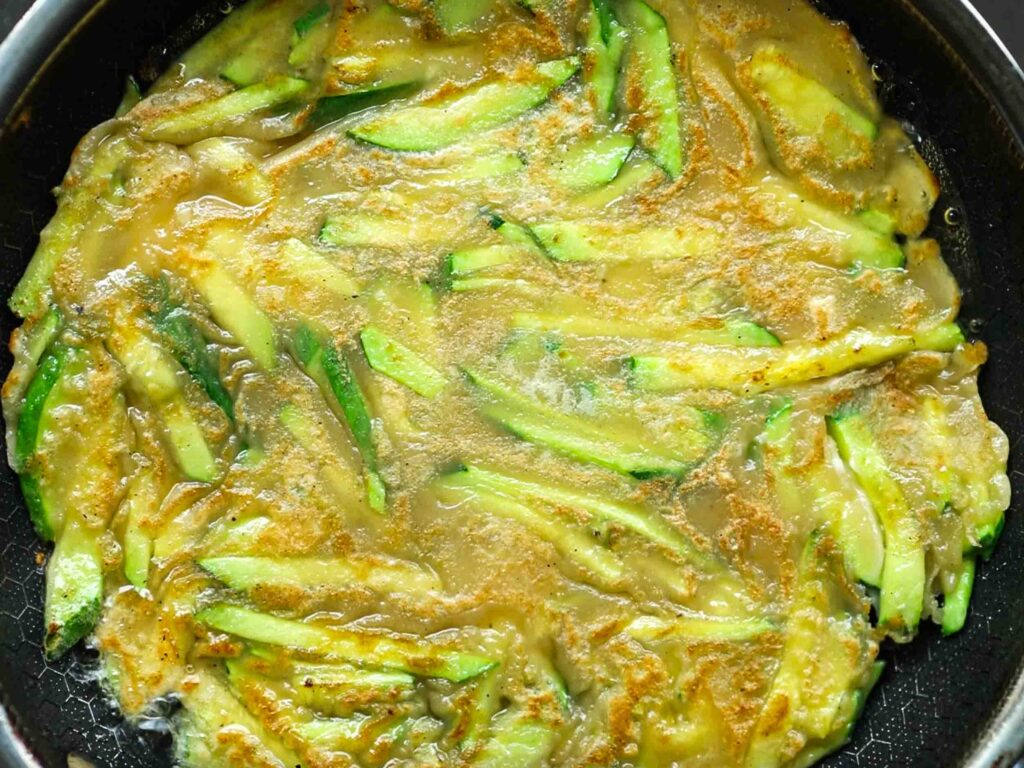
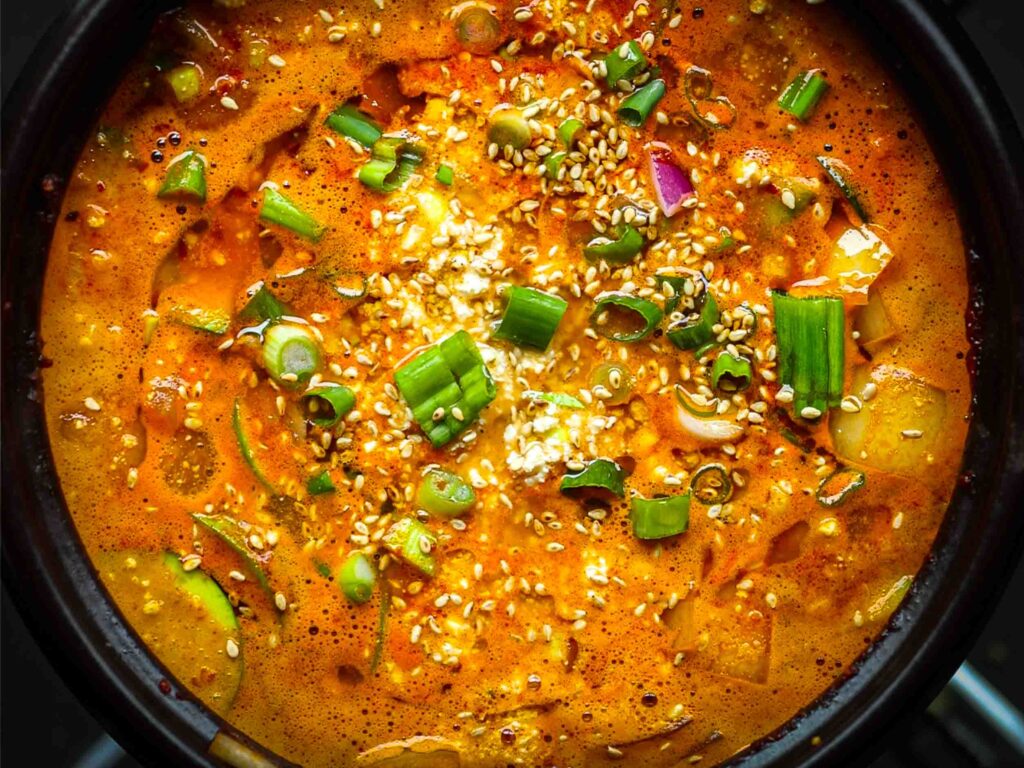
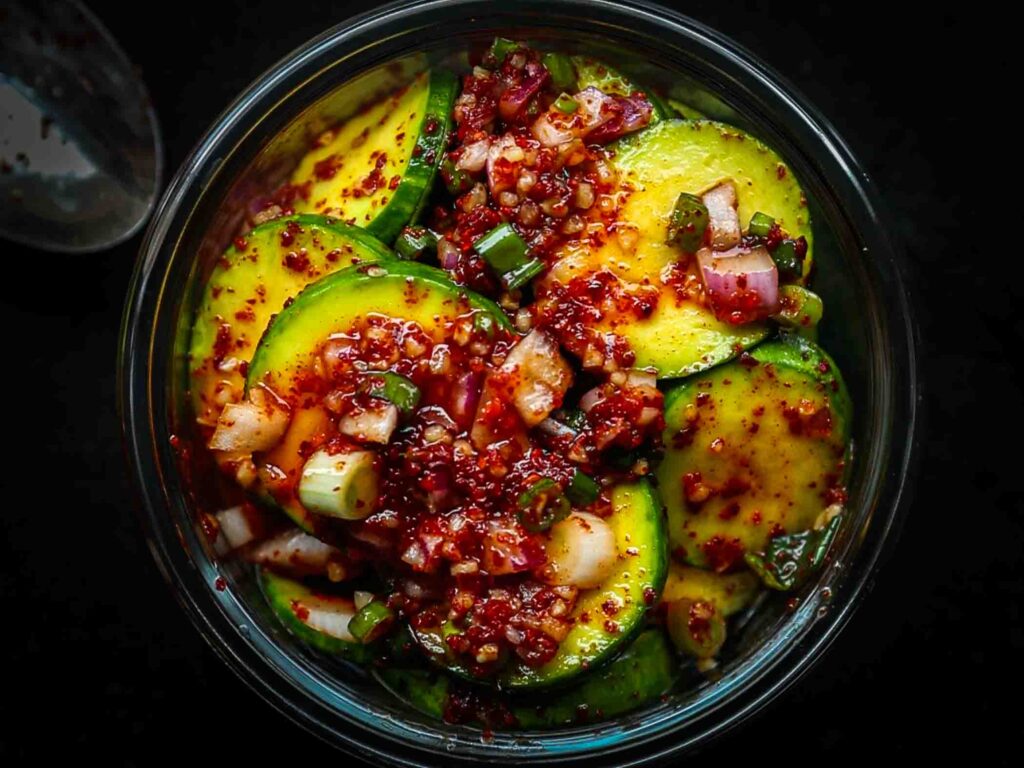
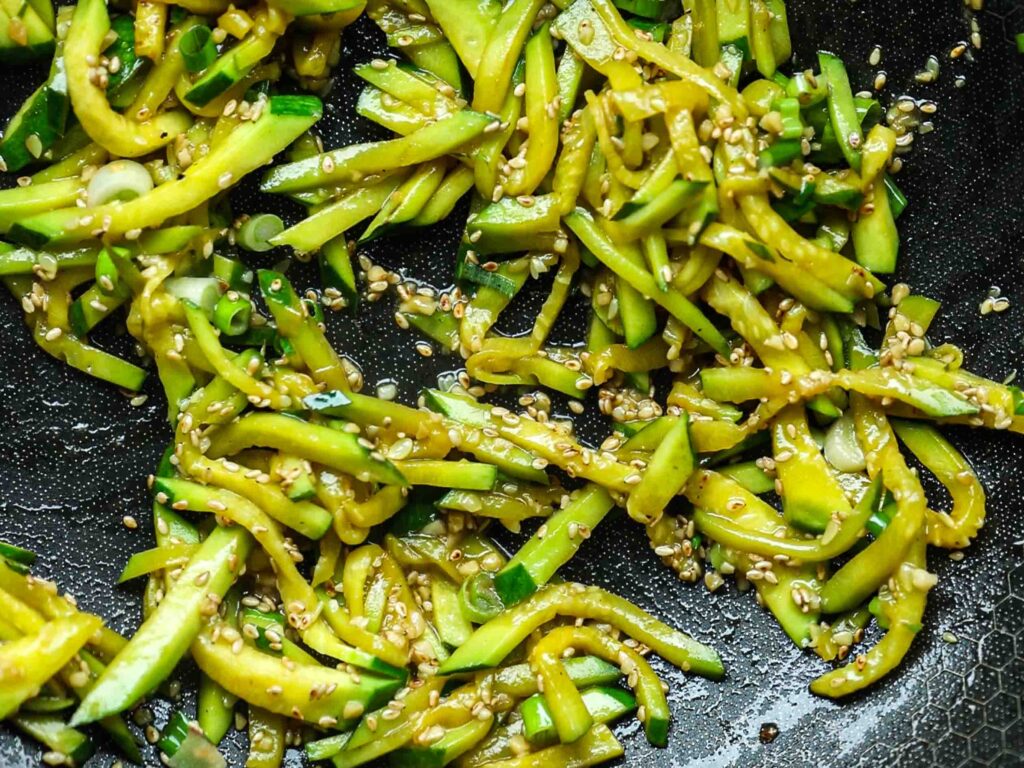
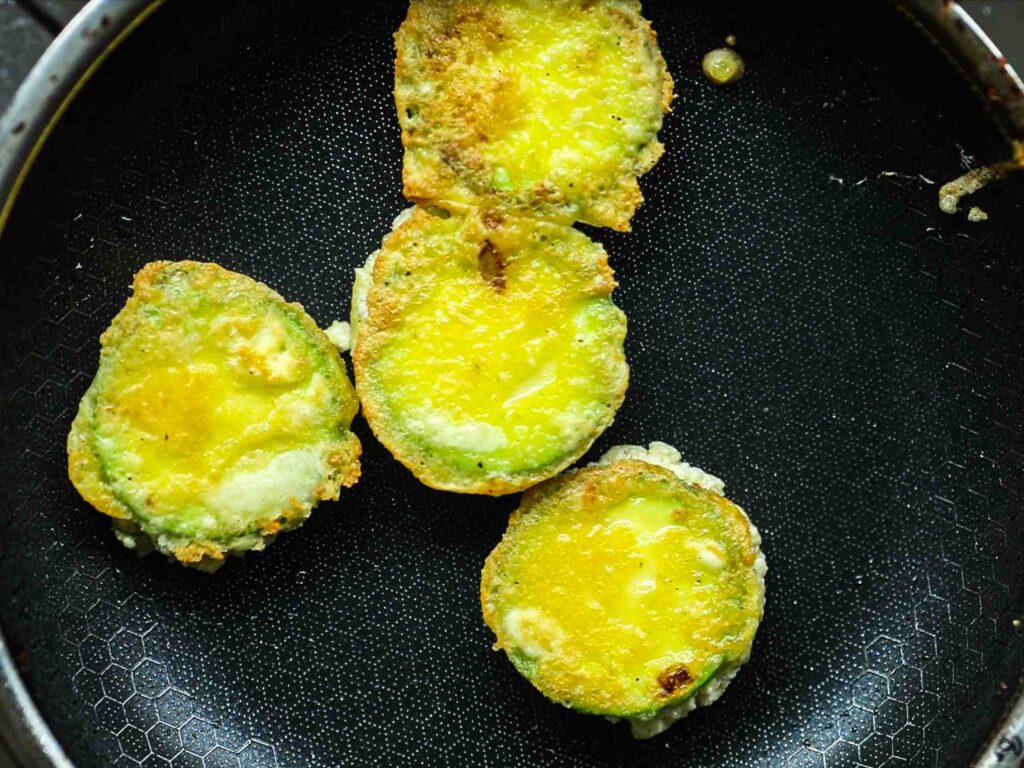
If you are at all familiar with Korean cuisine, then you already know that the Korean dining table is laden with lots of Korean “side dishes” or “banchan.” As a result, Korean food is all about meal prep–you make your side dishes in advance so you can bust ’em out and wow everyone at meal time!
These five Korean zucchini recipes will get you well on your way to populating your dining table with beautiful banchan that are sure to impress:
- Korean Zucchini Kimchi. The first Korean zucchini recipe involves zero cooking! As the name suggests, we pickle the zucchini by first drawing out the excess moisture with a little sea salt. We then add many of the same flavors you’ll remember from Napa cabbage kimchi! Only this kimchi will be 100x easier than cabbage kimchi, I promise!
- Korean Zucchini Banchan. The second Korean zucchini side dish is what my mom refers to as hobak banchan (“zucchini side dish”) or hobak bokkeum (“stir-fried zucchini”). It’s a very simple recipe, featuring julienned zucchini and utilizing only a handful of ingredients, but man oh man–it packs a lot of flavor!
- Korean Zucchini Pancakes. Korean zucchini pancakes are one of the most popular Korean dishes, often going viral on TikTok. We’ll keep it super simple, to make sure that the zucchini is the real star to this recipe.
- Tofu Stuffed Korean Zucchini Fritters. This recipe is essentially a marriage of my Tofu Jeon recipe and my Hobak Jeon recipe (both of which you can find in my cookbook). Usually on the table for birthdays or holidays, like chuseok (Korean Thanksgiving Day), this Korean zucchini recipe will add a touch of luxury and heartiness to your Korean meal.
- Gochujang Korean Zucchini Jjigae. You cannot have a Korean meal without some type of soup or stew. This Korean zucchini recipe will feature one of the essential Korean pastes, gochujang, along with a LOT of zucchini. The resulting stew is a spicy and addictive flavor bomb that perfectly complements the other four Korean zucchini recipes!
Key Ingredients Notes on Substitutions for these Korean Zucchini Recipes.
The following are some recommended substitutions to certain ingredients for these Korean zucchini recipes:
- Korean Zucchini. As we discussed above, Korean zucchini or aehobak is a specific type of summer squash that is distinct from regular zucchini. However, you can substitute with regular zucchinis or even grey zucchinis for all of these recipes.
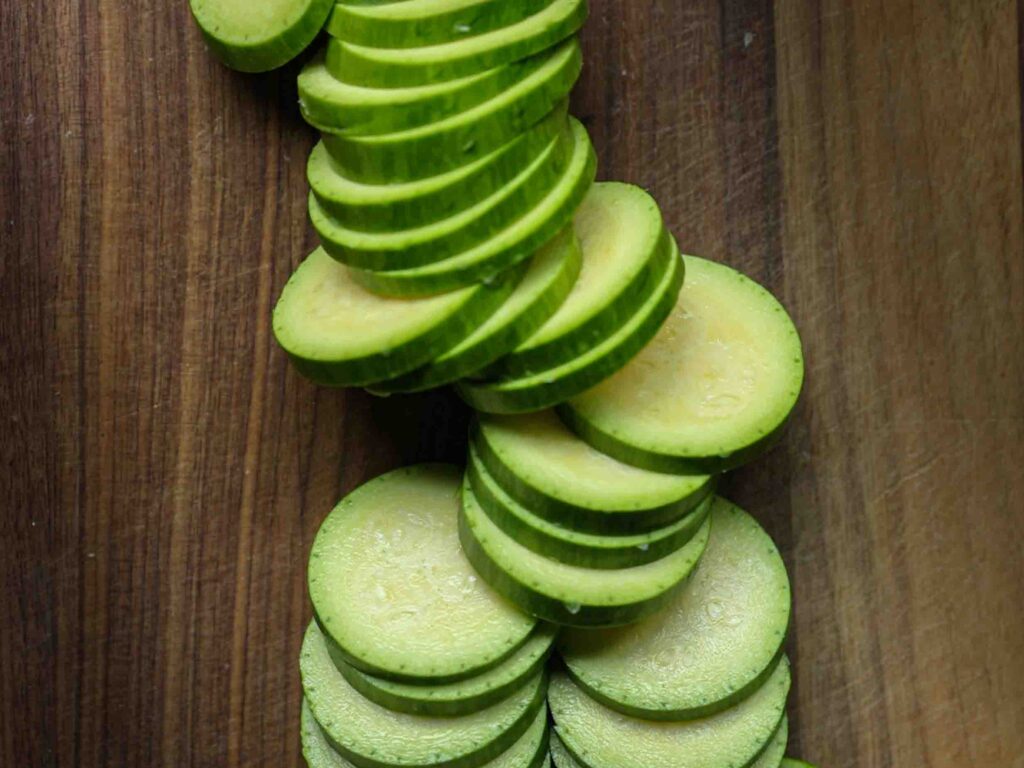
- Soy Sauce. Soy sauce will add deep umami to many of these Korean zucchini recipes, so get your hands on a good one the next time you’re out shopping for Korean ingredients. If you are allergic to soy, there are some great no-soy alternatives, including this no-soy, gluten-free seasoning sauce. You can, of course, also use coconut aminos.
- Sesame Oil. Toasted sesame oil (not the cold pressed kind) will add just a touch of richness to these Korean zucchini recipes. A little goes a long way, so you won’t need a lot. You can find my favorite Korean sesame oil here. If you don’t have sesame oil, you can simply add an extra helping of toasted sesame seeds as garnish or your favorite cooking oil.
- Gochugaru. Gochugaru or Korean pepper flakes provide both heat and a sweet smokiness to your Korean zucchini kimchi and Gochujang Korean Zucchini Jjigae. You can also modify the spice level with the kind and amount of gochugaru you add to your kimchi noodles recipe. For the Korean Zucchini Kimchi, there really is no good substitute for gochugaru. However, for the Gochujang Korean Zucchini Jjigae, If you can’t get your hands on gochugaru, you can substitute with more gochujang (to ensure the correct and desired depth of flavor).
- Gochujang. Gochujang or Korean pepper paste provides intense umami flavor (the paste is made of fermented soybeans), more heat, and a little sweetness to your Gochujang Korean Zucchini Jjigae. It should come as no surprise that there is no substitute for gochujang for the Gochujang Korean Zucchini Jjigae.
- Plum Syrup. I like using plum syrup for the Korean Zucchini Kimchi, but you can substitute your favorite unrefined sweetener: brown rice syrup, coconut sugar, date sugar, etc.
- Rice Vinegar. Again, feel free to substitute with your favorite vinegar, one that’s naturally sweet, like apple cider vinegar, raspberry vinegar, etc.
- Mirin. Mirin helps to amp up the sweet-sourness of the Korean Zucchini Kimchi, but if you don’t have any, you can simply substitute with a second splash of vinegar.
- Flour. For the Korean Zucchini Pancakes, I utilize all purpose flour. You can, however, substitute with your favorite gluten-free flour blend. However, the pancakes will likely be much softer and you may have to increase your cook time (i.e., the amount of time to cook each side of your pancakes).
- JUST Egg. For the Tofu Stuffed Korean Zucchini Fritters, I use JUST Egg, a vegan egg-substitute, for the egg batter. If you cannot get your hands on JUST Egg, you can always make a quick substitute by whisking together 2 to 3 tablespoons of potato starch, 1/4 cup plant milk, 1/4 teaspoon ground turmeric, and 1/2 teaspoon garlic powder. It should be the consistency of pancake batter.
How to Make These 5 Korean Zucchini Recipes.
Korean Zucchini Kimchi.
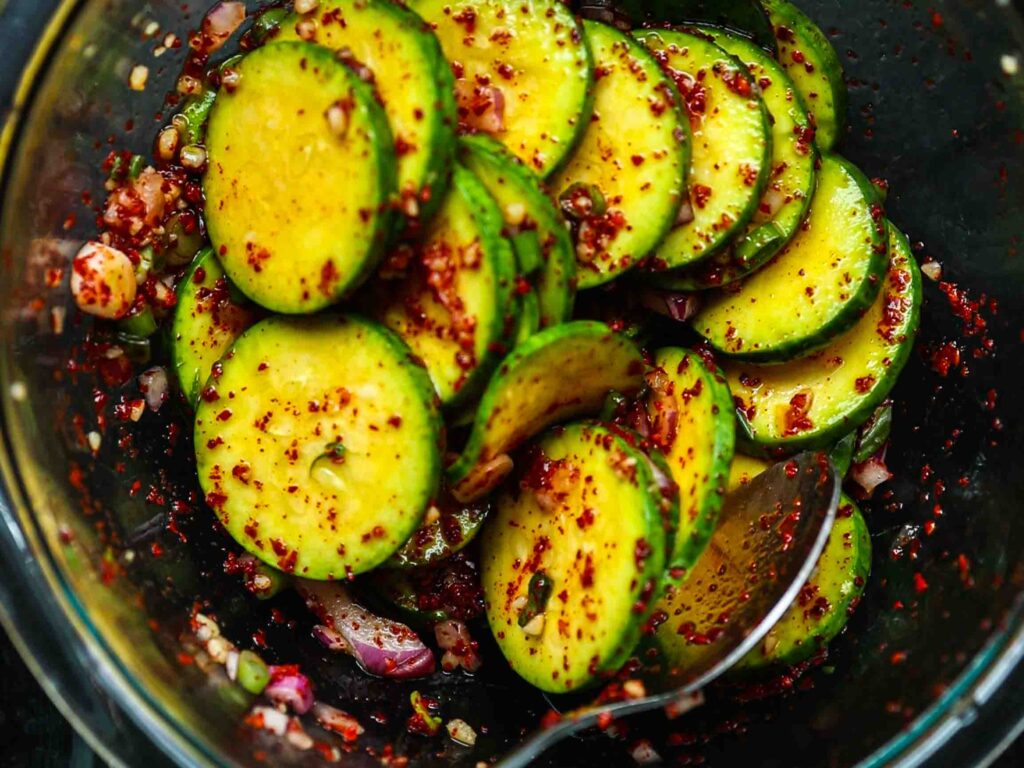
Of the five Korean zucchini recipes, this recipe is the easiest, since it involves no cooking! The first thing you’re going to do is slice the fresh zucchini into thin, round slices (around 1/4-inch thick slices). Place the zucchini slices into a large bowl and sprinkle with coarse sea salt. Set that aside until the zucchini slices become “bendy.” This shouldn’t take a very long time–roughly 20 to 25 minutes. You should see a bunch of liquid collecting at the bottom of your bowl.
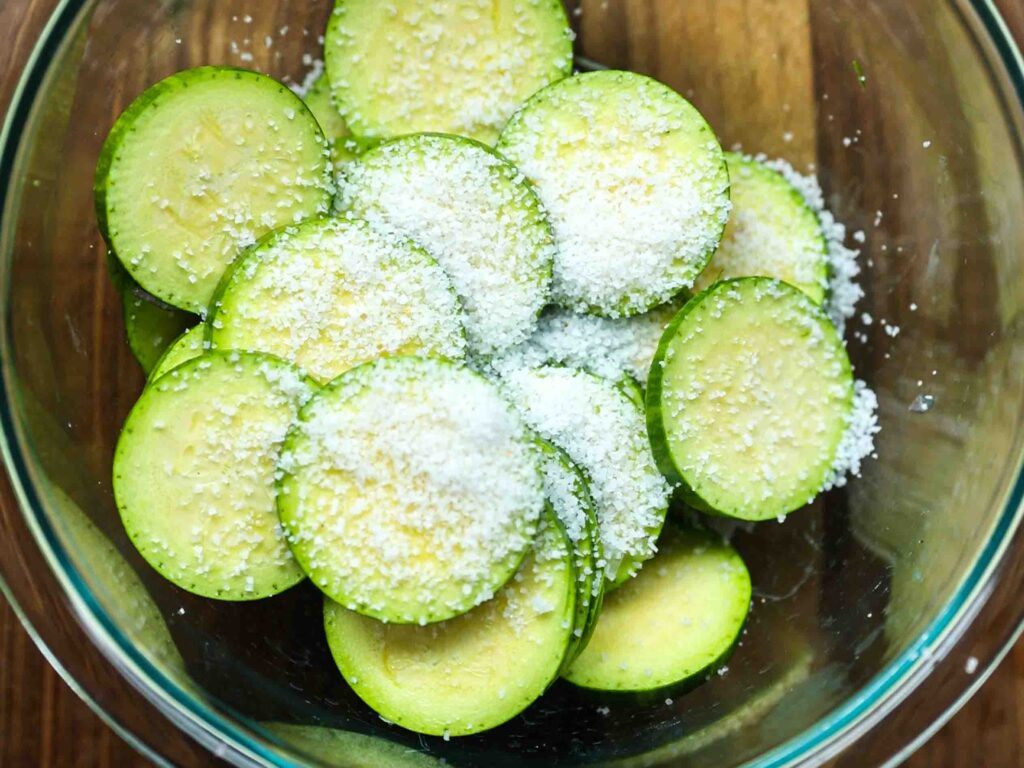
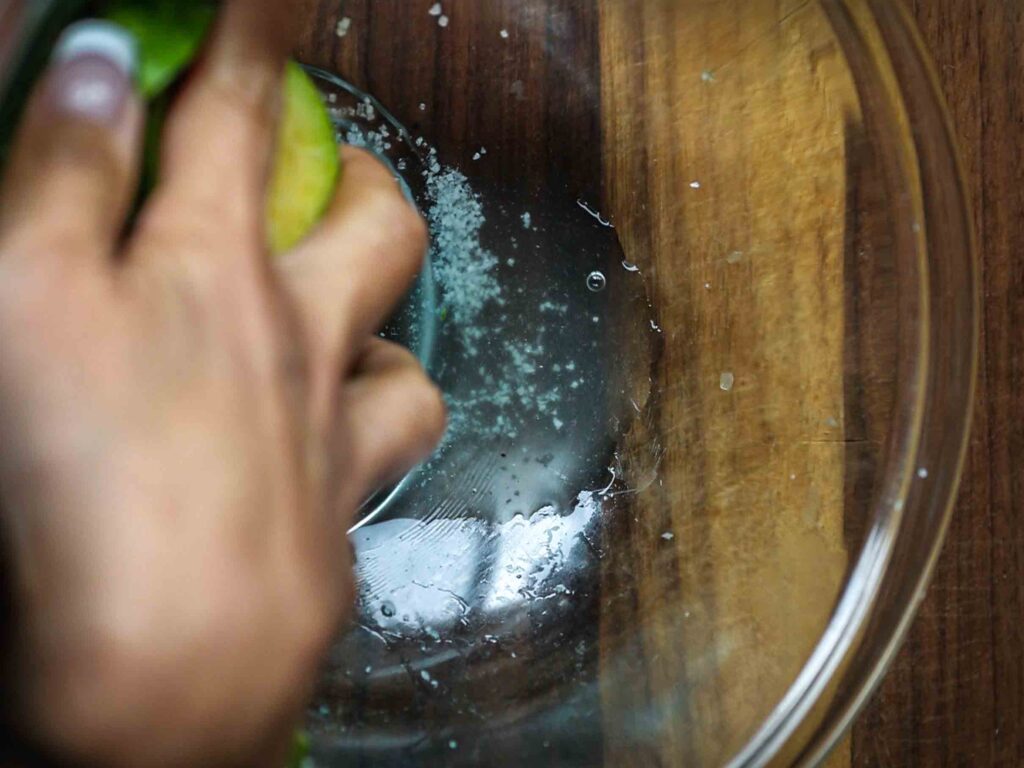
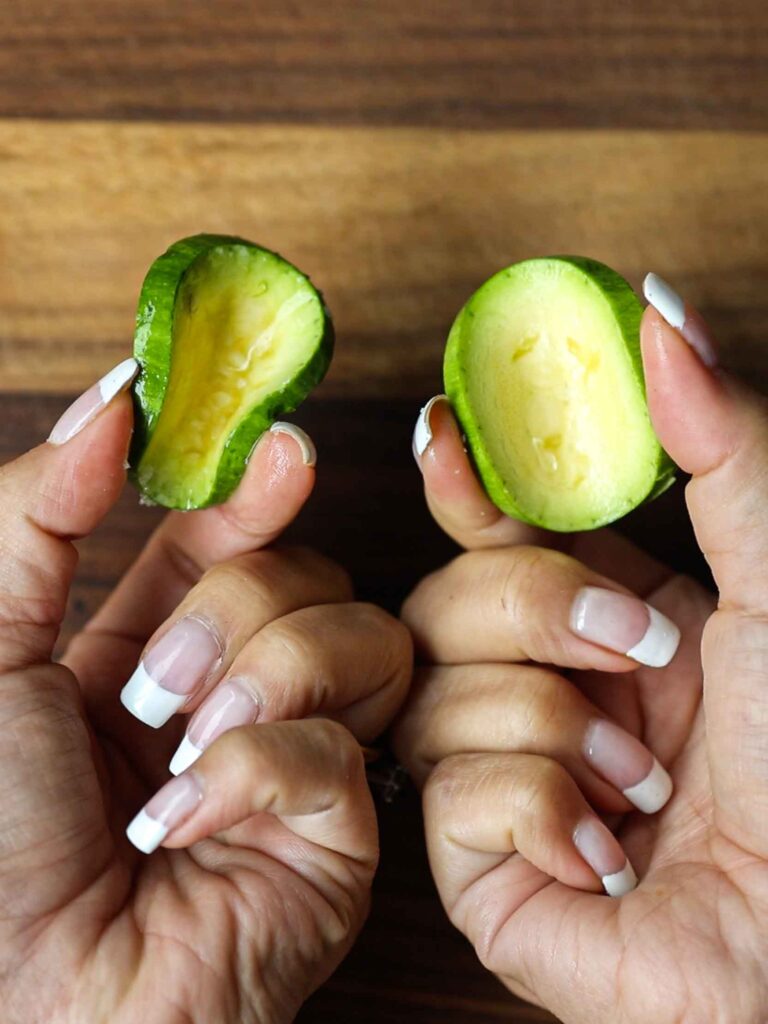
Rinse the zucchini slices in cold water at least twice in order to make sure they aren’t too salty. Then, place them in a large bowl and add the remaining ingredients: green onions, red onion, garlic, gochugaru, plum syrup, mirin, and rice vinegar. Mix well and you are ready to eat!
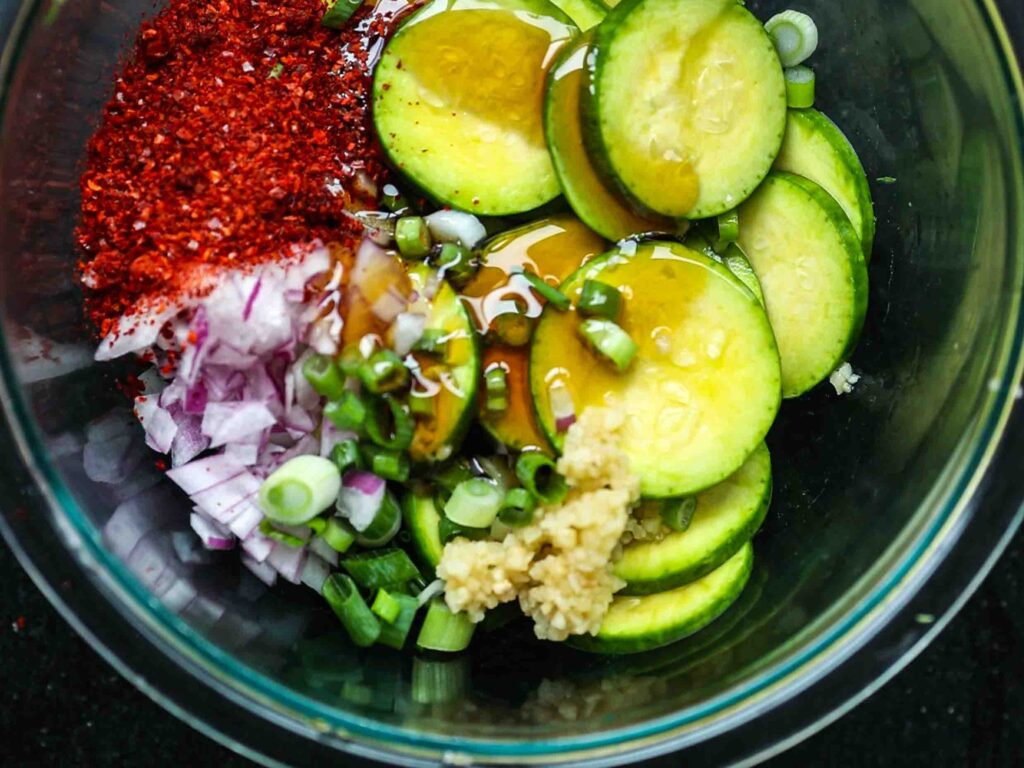
Korean Zucchini Banchan or Bokkeum.
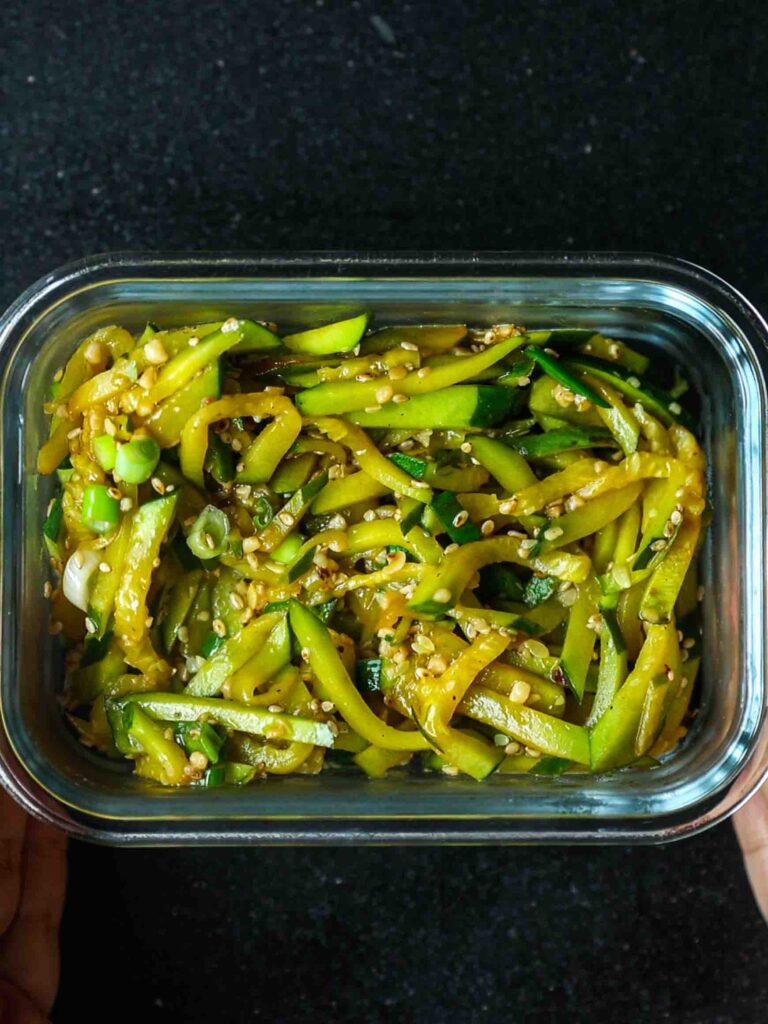
This is hands down one of my favorite Korean zucchini recipes because of how much deliciousness you get from such a simple recipe! My mom makes this for me all the time when I come home!
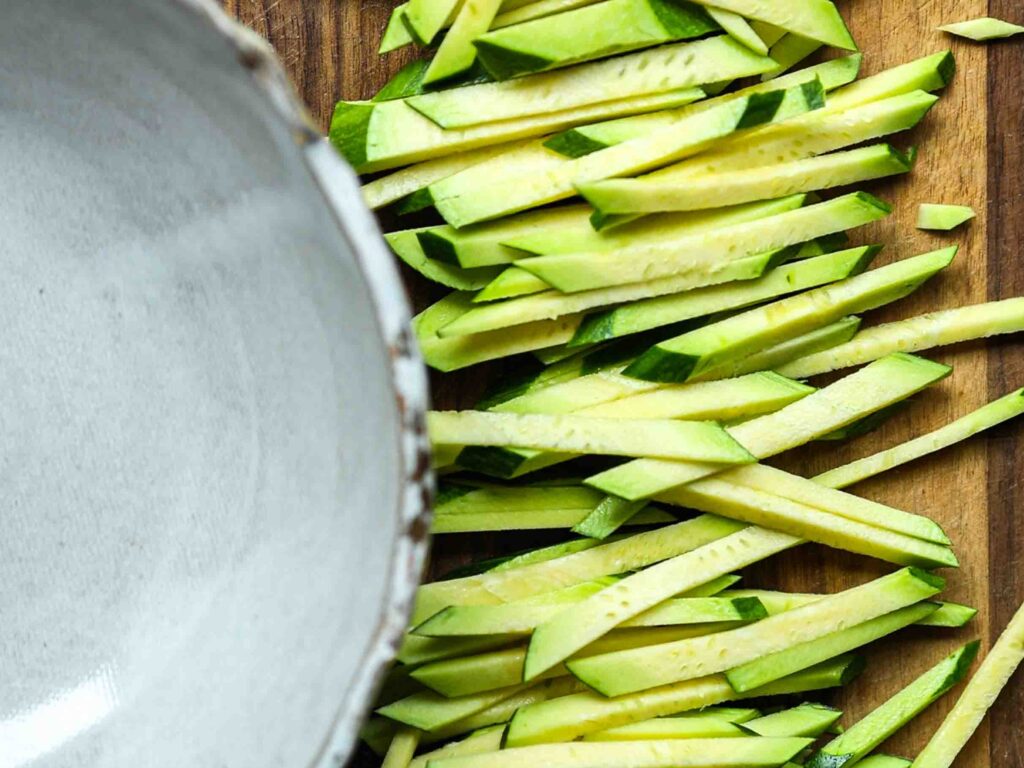
Begin by chopping your Korean zucchini into matchsticks (also referred to as julienne). Next, add a little vegetable or olive oil to a large skillet or wok over medium heat. When the oil begins to shimmer (about 1 minute), add the julienned zucchini and a little garlic and stir fry for about 2 minutes, until the zucchini begins to soften. Turn off the heat and add soy sauce, sesame oil, green onions, sesame seeds, and a couple cracks of black pepper. Done!
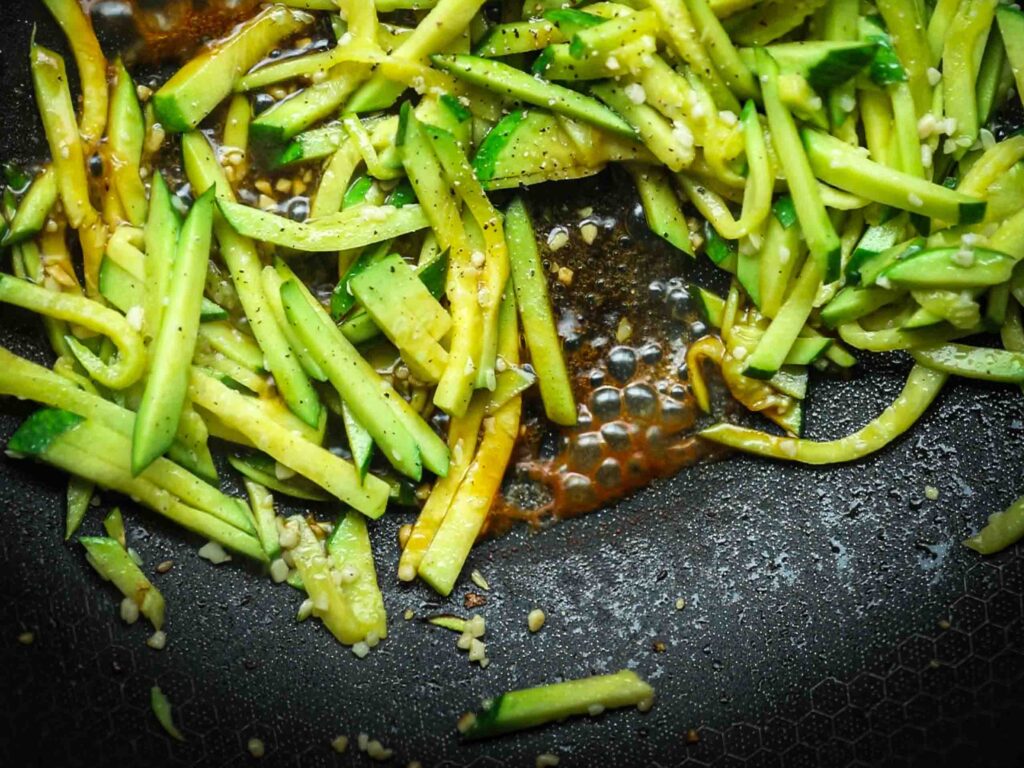
Korean Zucchini Pancakes.

These Korean pancakes were one of the first things my mom started making for me when I went vegan. And here’s the thing: my husband and I cannot get enough of them! Honestly, you can make them with all sorts of vegetables (potatoes, perilla leaves, mushrooms, scallions), but I love making them with Korean zucchini because you can really taste that sweet summer flavor!
Begin by julienning the zucchini and placing them in a small mixing bowl. Next, add 1 cup of flour (you can sub in your favorite gluten-free flour blend) and 1/4 cup of corn or potato starch. Season with black pepper and a little garlic powder. Then, for your liquids, add a little soy sauce for flavor and vegetable broth to make the batter (you can also substitute with water). You should have a very thick batter–a little bit thicker than your typical pancake batter.
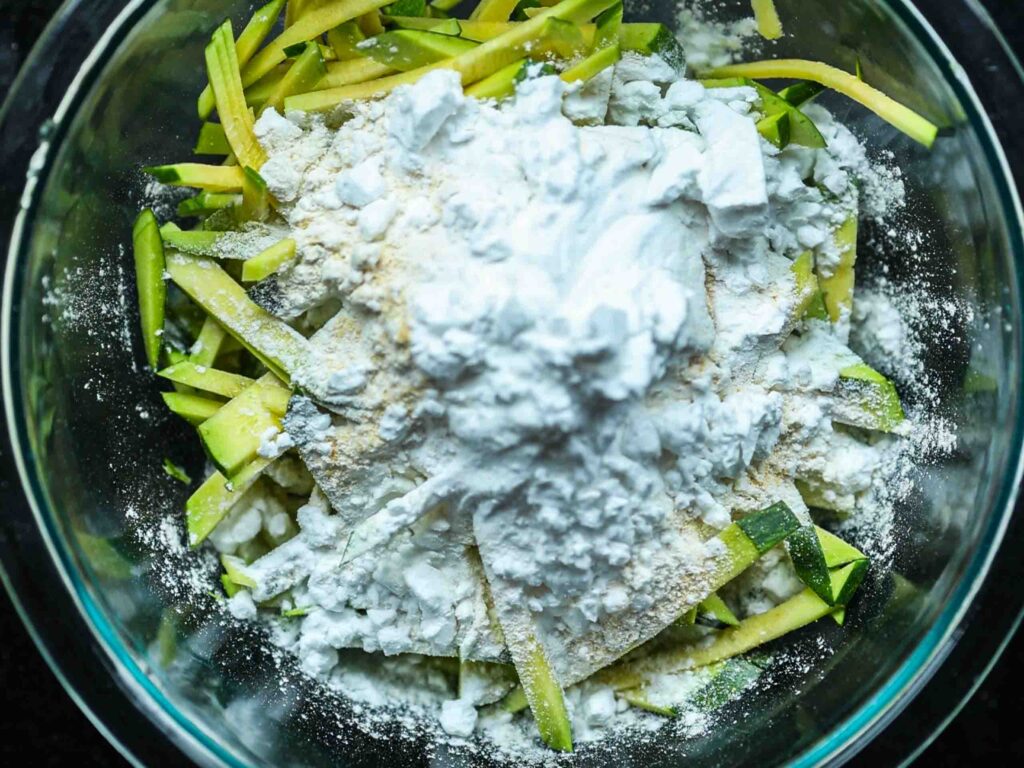
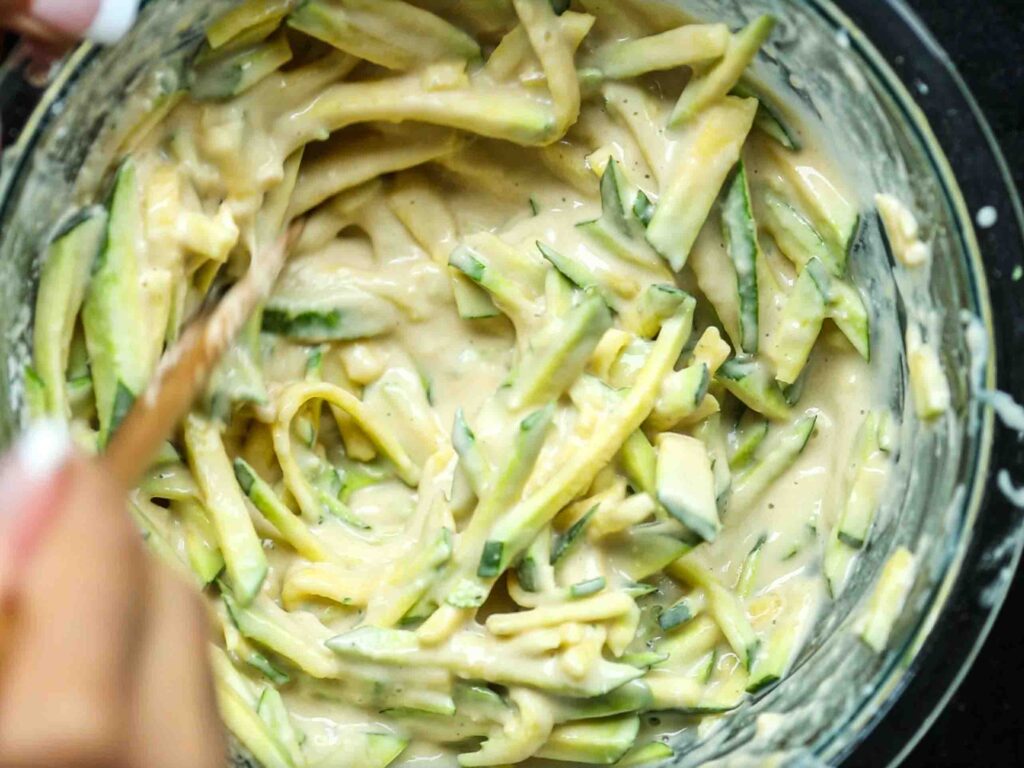
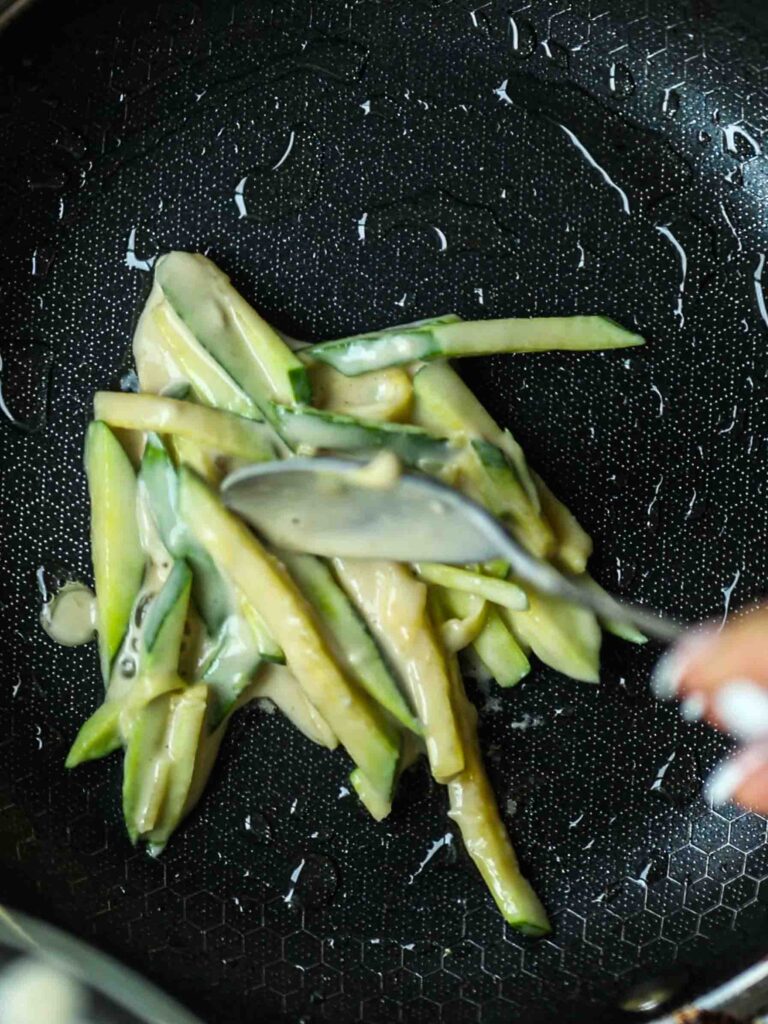
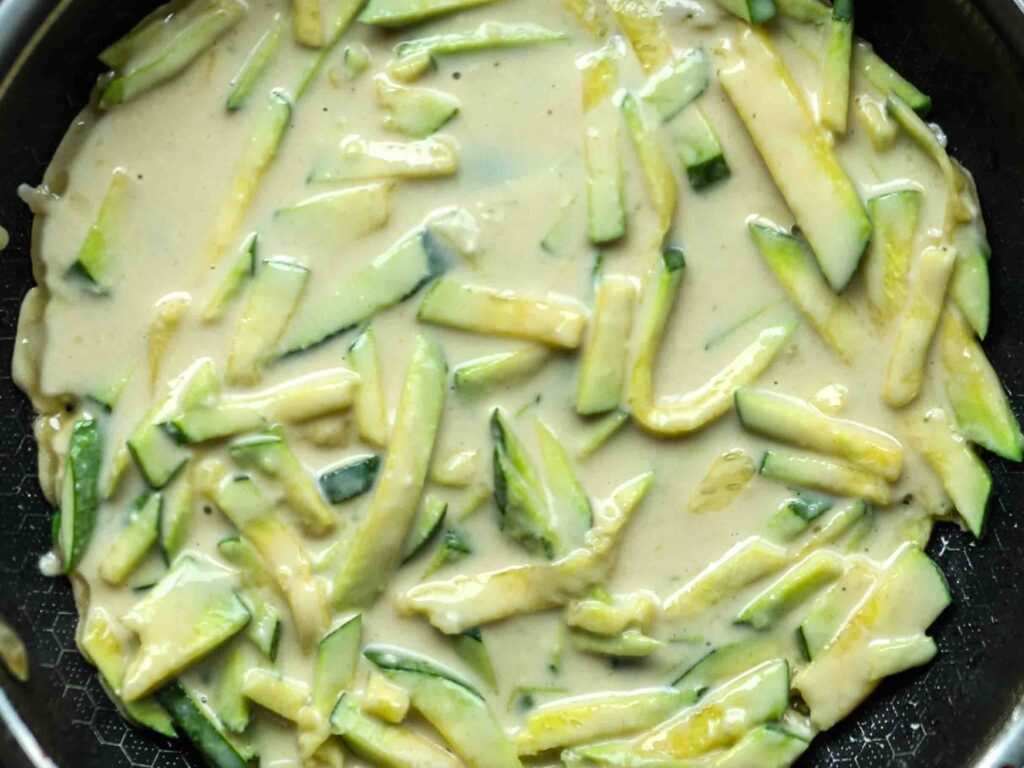
Add a little vegetable oil to your non-stick skillet over medium heat. Then, pour about 1/4 cup of your batter onto your pan and cook for about 2 minutes. Flip and repeat. And that’s it! Serve with your favorite dipping sauce or by itself (they’re that good!).
You’ve knocked out 3 of the 5 Korean zucchini recipes!!
Tofu Stuffed Korean Zucchini Fritters.
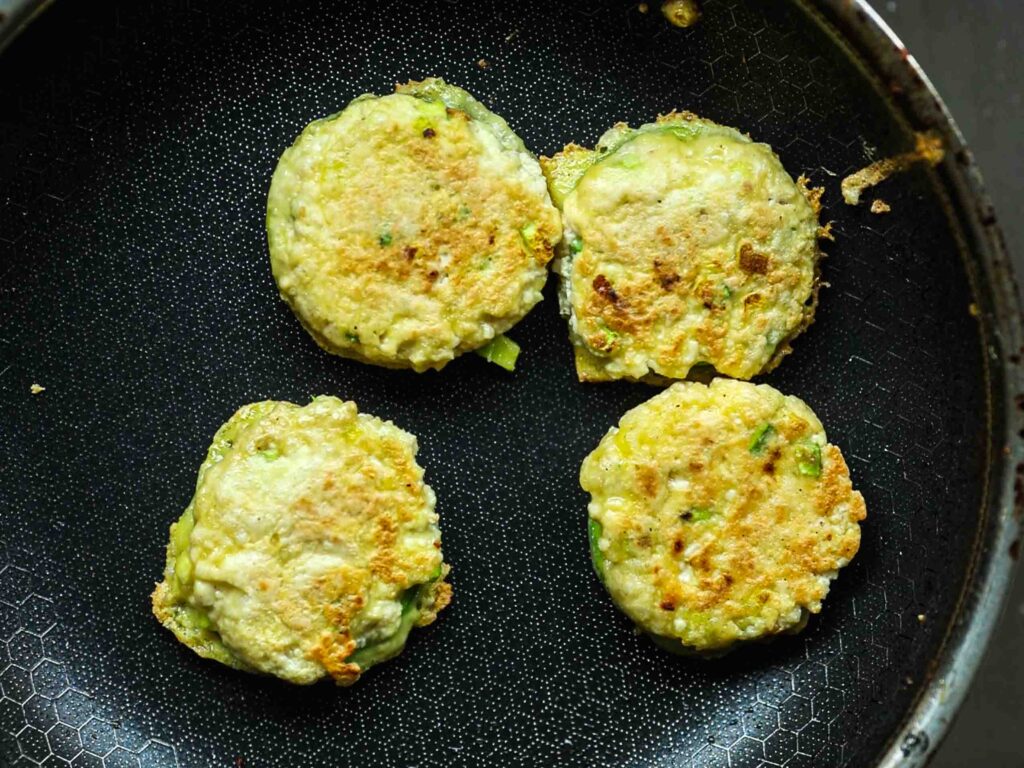
As I mentioned before, this Korean zucchini recipe is the result of joining my hobak jeon and dooboo jeon recipes. This is a bit of a fancier recipe and therefore may take a teensy weensy bit of practice. No matter what, they will be delicious!
First, julienne your zucchini. Then, dice up the julienned zucchini so you get a very small dice. Next, slice up some zucchini into medallions, about the same thickness as you did for the zucchini kimchi. To make the tofu stuffing, mash up some super dense tofu (or pressed extra firm tofu) into a small bowl. Add to it the small diced zucchini, just a little soy sauce, and a bit of sesame oil. Mix until well-combined.
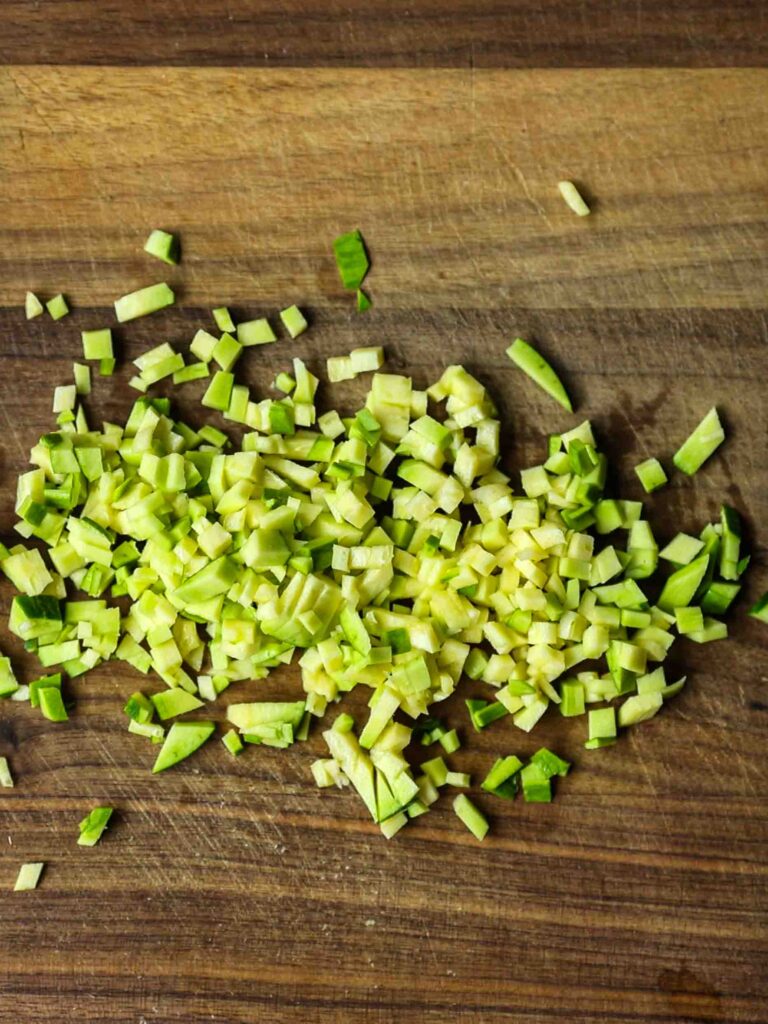
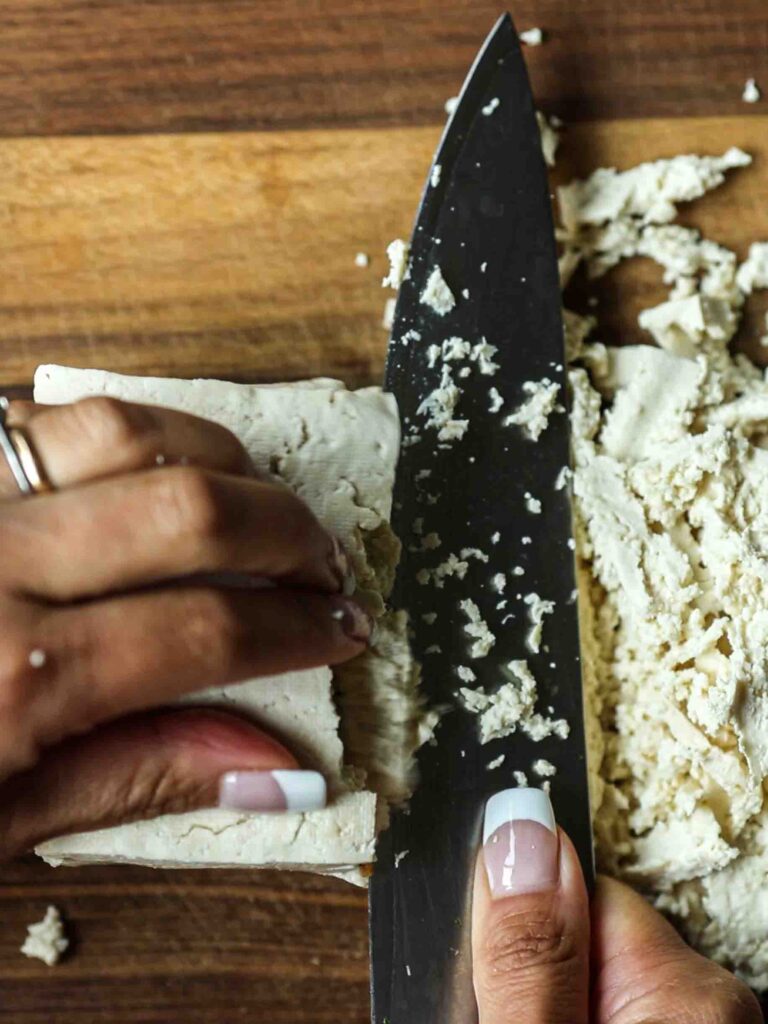
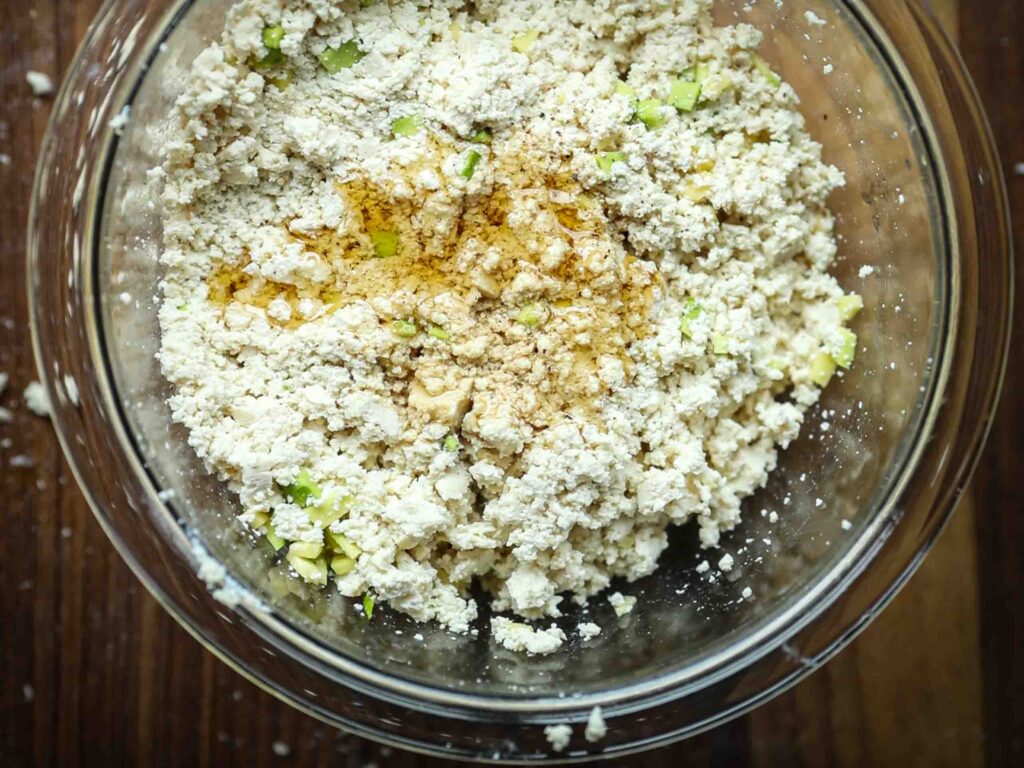
Set two small bowls next to your skillet–one containing JUST Egg (or substitute, see note above) and some salt and pepper, and the other containing potato starch (or corn starch). Place a non-stick skillet on the stove over medium heat and brush a little vegetable oil on top of it. Then, take a zucchini medallion and 1 tablespoon of the tofu stuffing and shape it over the top of the medallion. Coat the entire thing with potato starch, tap off any excess, and then dip it in the JUST Egg. Place medallion side down on the skillet and cook for about 2 minutes.
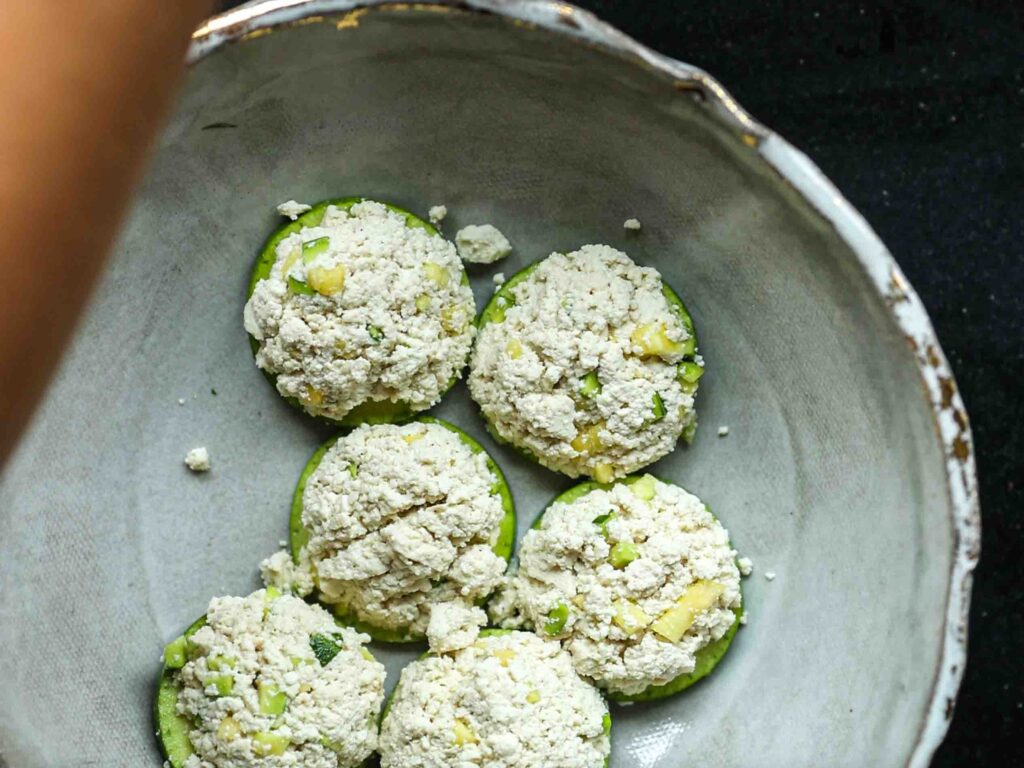
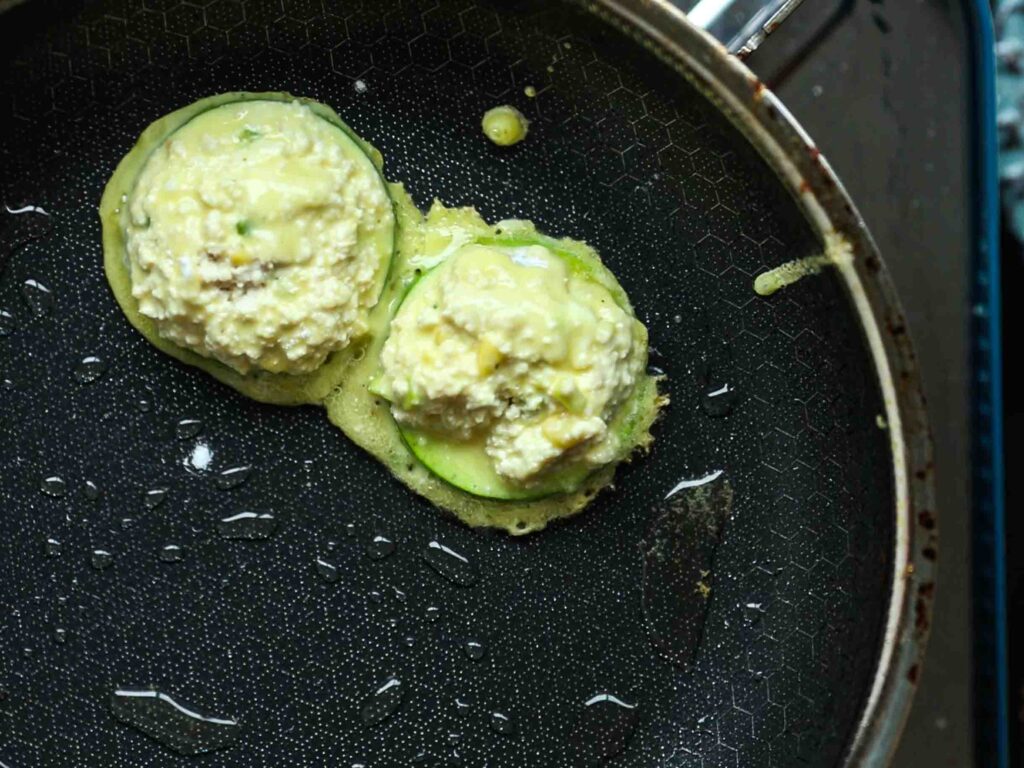
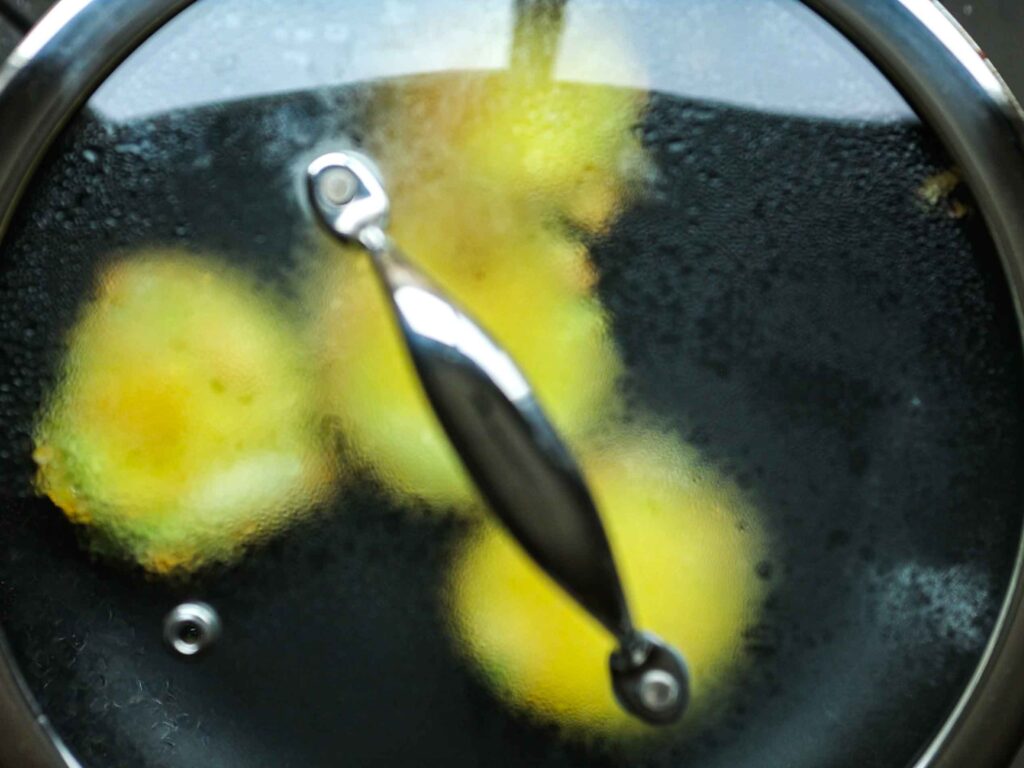
Flip the fritters so that they are now tofu side down. Place a lid on top of your pan and cook for another 2 minutes. This will help to steam-cook the sides of your jeon. Serve with your favorite dipping sauce (see below for video on my favorite dipping sauce)!
Gochujang Korean Zucchini Jjigae.
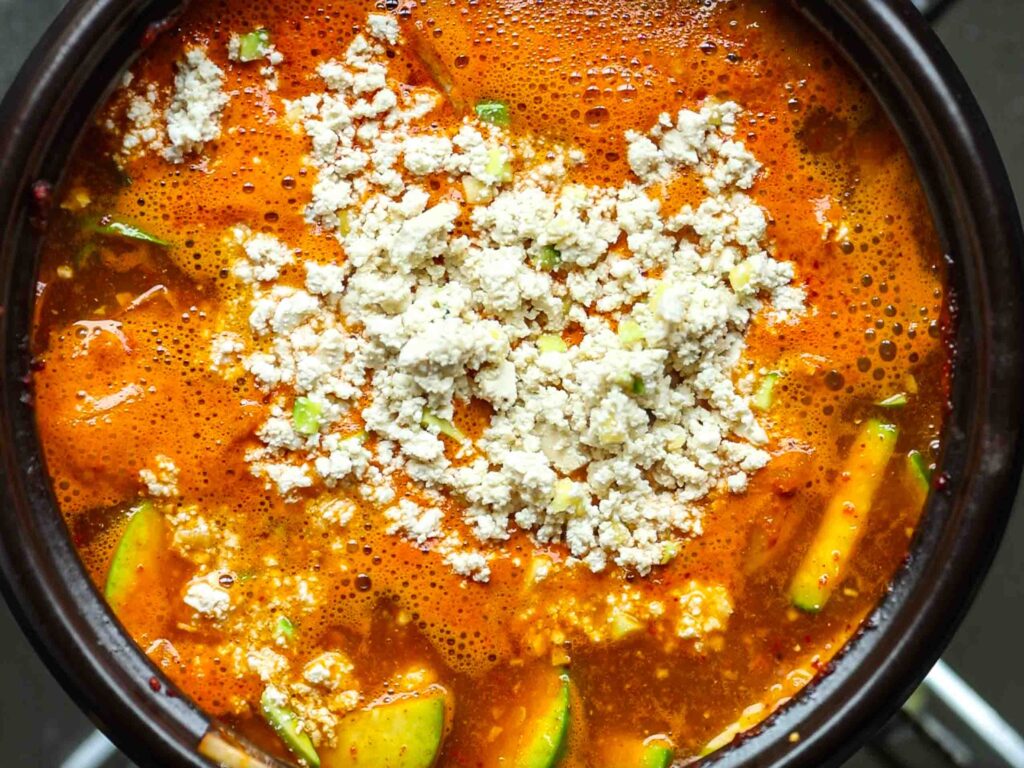
The fifth and final recipe of the Korean zucchini recipes is a Korean stew or jjigae. This stew is the perfect thing to round out the above four Korean zucchini recipes. Moreover, it’s extremely easy to make!
Begin by adding a little sesame oil to a small Dutch oven or ddukbaeggi (Korean clay pot) over low heat. Next, add your gochugaru and stir. When the gochugaru begins to froth (about 1 minute), add your onion, garlic, and zucchini. Cook for about 1 minute, until the onions start to get soft. Then, add your gochujang and mix everything until the vegetables are evenly coated. Deglaze your pot with soy sauce (guk ganjang or soup soy sauce if you have it) and stir. Add vegetable broth and bring everything to a boil. Then, reduce your heat and let the pot simmer for about 15 minutes.
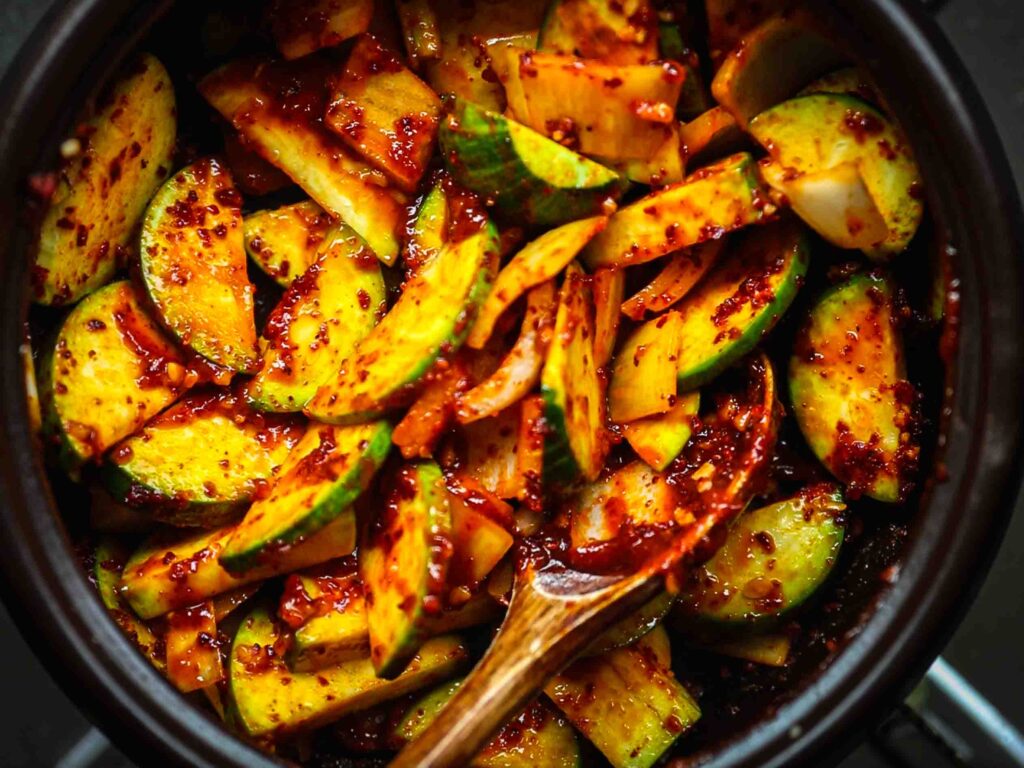
For a little protein, add some super firm or extra firm tofu. You can slice up the tofu OR use some of the leftover crumbled tofu you had from your zucchini fritters (no waste!). Cook for another 3 minutes and then garnish with a little sesame oil, sesame seeds, scallion greens, and black pepper.
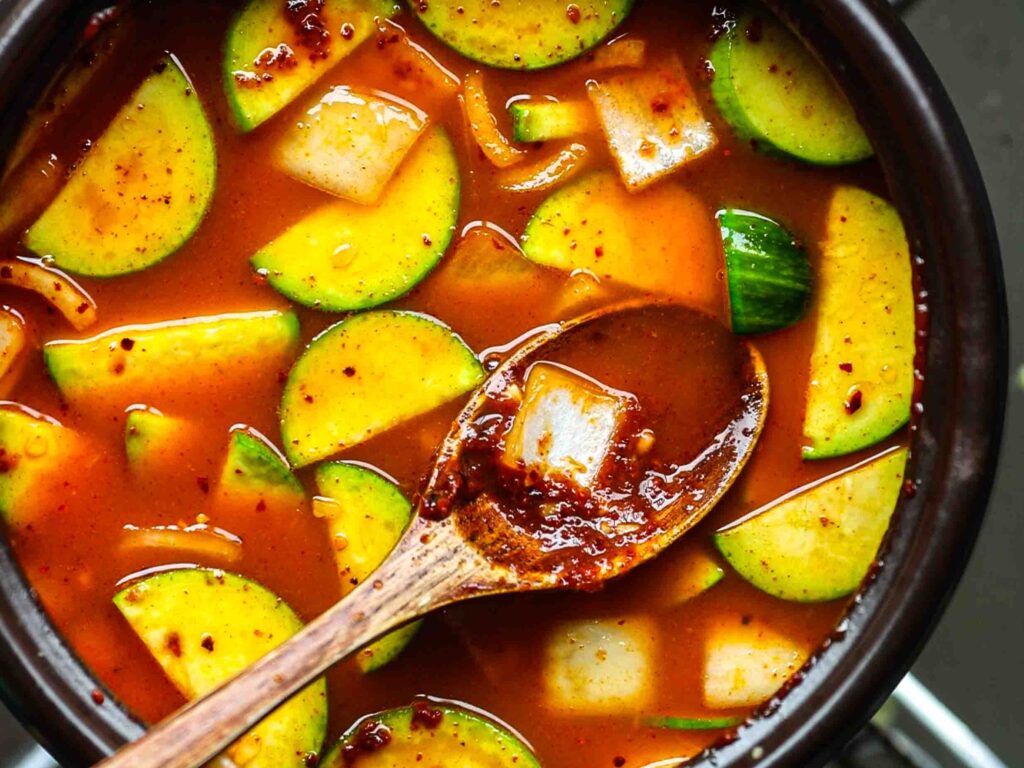
Congratulations!! You have completed making all five Korean zucchini recipes!! You’re basically an ajummah!!
Korean Grocery Shopping List for Korean Zucchini Recipes.
Although there aren’t a lot of ingredients for these 5 Korean zucchini recipes, the following is a handy dandy shopping list for your next visit to the Korean grocery store:
- Korean zucchini
- Soy sauce
- Toasted sesame oil
- Toasted sesame seeds
- Gochujang
- Gochugaru
- Rice vinegar
- Mirin
- Plum syrup
Frequently Asked Questions.
How is Korean zucchini different from regular zucchini?
Korean zucchini or “aehobak” has a much brighter green color (neon or lime green) and a yellowish flesh. This Korean summer squash also has thinner skin than regular zucchini and a sweeter taste.
Can you make Korean Zucchini Pancakes gluten-free?
Yes. Simply substitute the all purpose flour with your favorite gluten-free flour blend and make sure to use a gluten-free soy sauce for the batter.
Does Korean cuisine incorporate a lot of zucchini?
Yes. Many Korean recipes feature zucchini, including zucchini pancakes, zucchini fritters (hobak jeon), stir-fried zucchini (hobak bokkeum), and several different kinds of jjigae or Korean stews (e.g., gochujang jjigae, doenjang jjigae, soondooboo jjigae).
Recipe Cards.
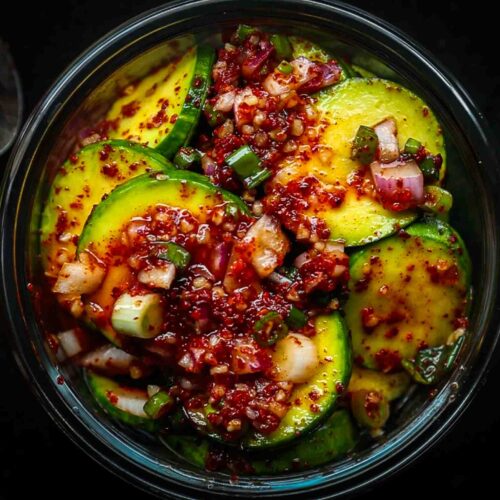
Korean Zucchini Kimchi.
Ingredients
- 2 medium zucchini, sliced into 1/4-inch thick medallions
- 3 tbsp course sea salt
- 1/4 cup diced red onion
- 1/4 cup chopped green onion
- 2 tbsp minced garlic
- 1/4 cup gochugaru (can use less if too spicy)
- 3 tbsp plum syrup
- 2 tbsp mirin
- 2 tbsp rice vinegar
Instructions
- In a large bowl, mix together zucchini slices with salt. Set aside for about 20 to 25 minutes, until the zucchini slices are bendy.
- Rinse the zucchini slices thoroughly under cold water at least twice. Place back in a clean bowl. Add the remaining ingredients (red onion, green onion, garlic, gochugaru, syrup, mirin, and vinegar) and stir until well-combined.
- Can be enjoyed immediately or stored in an airtight container in the refrigerator for up to 10 days.
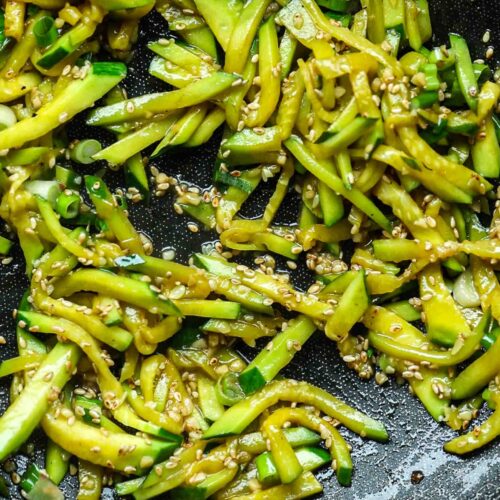
Korean Zucchini Banchan.
Ingredients
- 1 tbsp vegetable oil (or extra virgin olive oil)
- 1 tbsp minced garlic
- 2 medium zucchini, julienned
- 1 tbsp soy sauce
- 2 tbsp chopped scallion greens
- 1 tsp toasted sesame oil
- 1 tsp black pepper
- 1 tbsp toasted sesame seeds
Instructions
- Add oil to a large skillet or wok over medium to medium high heat. When the oil begins to shimmer (about 1 minute), add the minced garlic and cook for about 1 minute until fragrant. Add zucchini and stir-fry for about 2 to 3 minutes, until the zucchini begins to soften.
- Add soy sauce, scallion greens, and sesame oil and toss a couple times, until zucchini is evenly coated. Remove from heat and garnish with black pepper and toasted sesame seeds.
- Enjoy immediately or store in an airtight container in the refrigerator for up to 5 days.
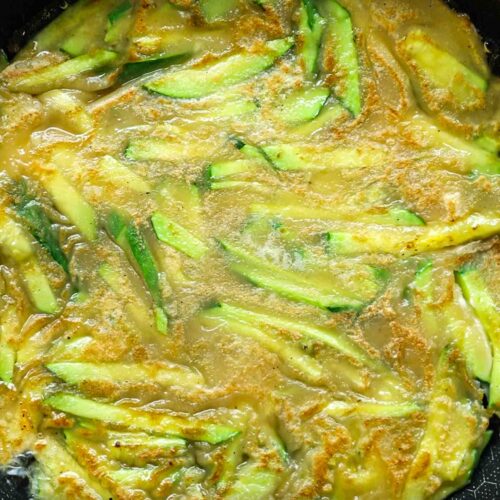
Korean Zucchini Pancakes.
Ingredients
- 1 medium zucchini, julienned
- 1 cup all purpose flour
- 1/4 cup potato starch
- 1 tbsp soy sauce
- 1 tsp garlic powder
- 1 cup vegetable broth
- 2 tbsp vegetable oil
Instructions
- In a bowl, mix together zucchini, flour, potato starch, soy sauce, garlic powder, and vegetable broth. This should create a fairly thick batter, but if it's too thick, add a tablespoon of vegetable broth until it reaches the desired consistency.
- Add a little oil to a non-stick skillet over medium heat. Then spoon about 1/4 cup of the batter onto the pan, shaping it into a rough circle, about 4-inches in diameter. Let it cook for about 2 minutes before flipping and cooking for an additional 2 minutes.
- Serve with dipping sauce or by themselves. These can be stored in an airtight container in the refrigerator for up to 3 days.
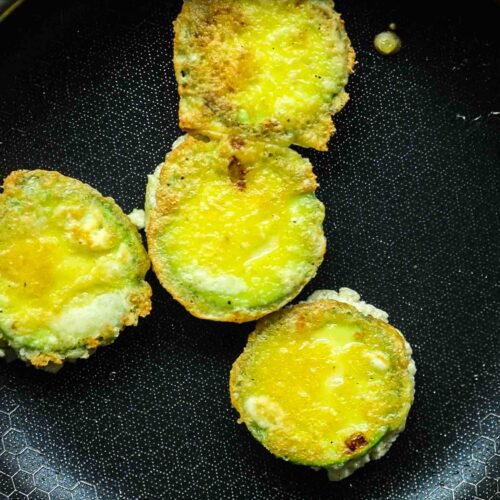
Tofu Stuffed Korean Zucchini Fritters.
Ingredients
- 1/4 cup small diced zucchini
- 10 oz super dense tofu (can substitute with pressed extra firm tofu)
- 1 tsp soy sauce
- 1 tsp sesame oil
- 1 tsp black pepper
- 20 zucchini slices (1/4-inch thick medallions)
- 1/4 cup potato starch
- 1/4 cup JUST Egg
- 1/2 tsp sea salt
- 2 tbsp vegetable oil
Instructions
- Mix together the small diced zucchini, super firm tofu, soy sauce, sesame oil, and black pepper.
- Get your non-stick skillet ready by adding a little vegetable oil over medium high heat.
- Take about 1 tablespoon of the tofu mixture and press it firmly on top of a zucchini medallion. You can flatten it out a bit to prevent the mixture from falling apart. Add a little salt and pepper to the JUST Egg. Coat the zucchini + tofu mixture with potato starch and then dip it into the JUST Egg, right before adding to your skillet, medallion side down.
- Cook for about 1 to 2 minutes (or until the bottoms are golden brown) and then flip. Cover the pan with a lid for about 2 minutes.
- Serve with dipping sauce or by themselves. Store in an airtight container in the refrigerator for up to three days.
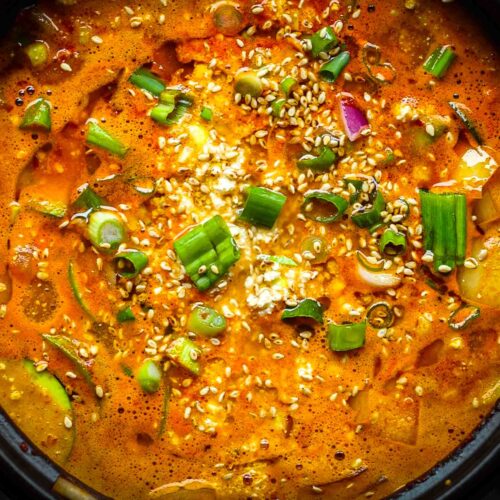
Gochujang Korean Zucchini Jjigae.
Ingredients
- 1 tbsp toasted sesame oil (plus more for garnish)
- 1 tbsp gochugaru
- 2 tbsp minced garlic
- 1/4 cup chopped onion
- 2 cups sliced zucchini (sliced into half moons)
- 2 tbsp gochujang
- 2 tbsp soup soy sauce
- 4 cups vegetable broth
- 8 oz super firm or extra firm tofu, sliced or crumbled
- 2 scallions, chopped
- 1 tbsp toasted sesame seeds
- 1 tsp black pepper
Instructions
- Add sesame oil to a medium Dutch oven or ddukbaeggi over medium-low heat. Add gochugaru and stir for about 2 minutes, until it starts to froth.
- Add onions, garlic, and zucchini. Stir and cook in gochugaru for about 1 minute, until onions begin to soften. Add gochujang and stir until vegetables are evenly coated. Deglaze the pot with soy sauce and stir. Then, add vegetable broth.
- Increase heat and bring the pot to a boil (about 2 minutes). Then reduce heat and allow the pot to simmer for about 15 minutes, until the zucchini is completely tender and the broth infused with their flavor.
- Add tofu and cook for about 3 more minutes. Garnish with scallion greens, sesame oil, black pepper, and toasted sesame seeds.

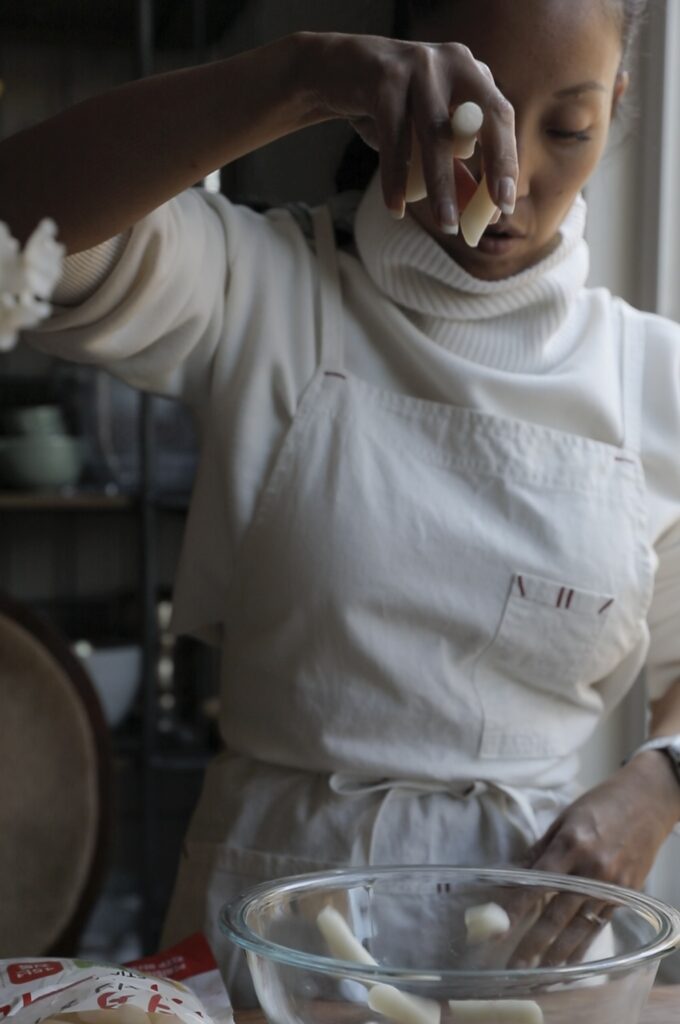


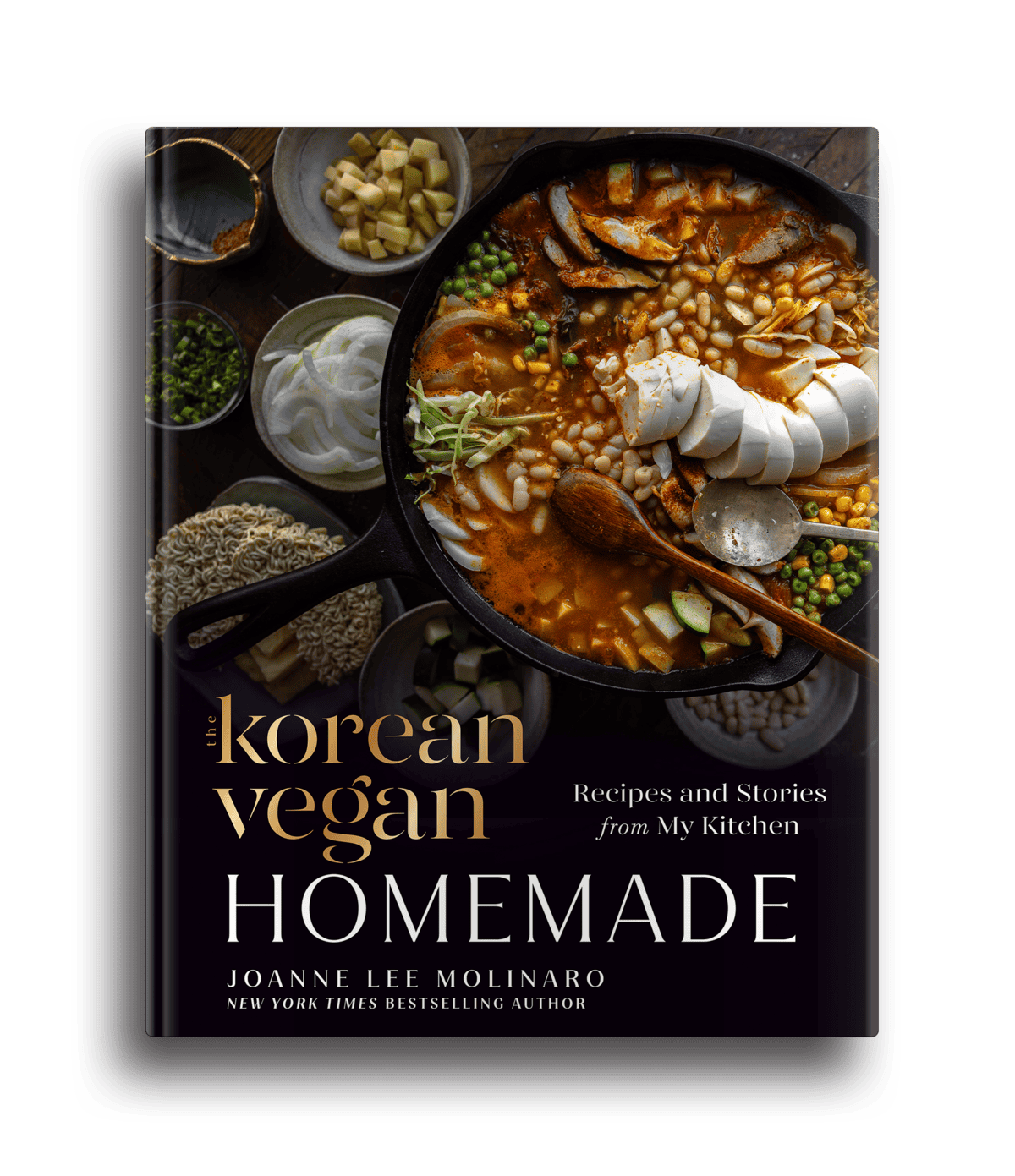
What did you mean JUST egg….
A vegan egg substitute. We don’t have JUST egg here but several others. You can even make your own vegan eggs.
Had all the ingredients so I made it ASAP. Perfect for winter here in Australia
So glad!! And hello from Los Angeles!!
Amazing!! So glad you tried it!!
Thank you so much for sharing the recipes and all of the notes. I’ll be making the Korean Zucchini Pancakes for company in a couple of days. Always appreciate your writing
Sharon! I hope the pancakes turned out well! I just made them for my father and mother and they LOVED them!